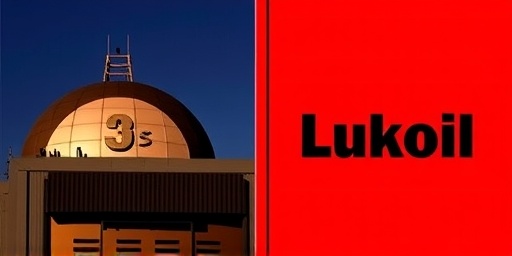In a move that sends shockwaves through the energy sector, the United States has enforced stringent sanctions on two of Russia’s largest oil producers, Rosneft and Lukoil, disrupting the flow of approximately 48 million barrels of Russian oil currently en route on tankers across the globe. Effective immediately, these U.S. sanctions aim to curb Moscow’s revenue streams amid ongoing geopolitical tensions, but they threaten to exacerbate supply chain vulnerabilities in the global crude market.
- New U.S. sanctions Freeze Rosneft and Lukoil’s International Deals
- 48 Million Barrels Adrift: Tanker Disruptions in the Global Crude Trade
- Oil Prices Surge Amid Fears of Russian Oil Supply Squeeze
- Geopolitical Ripples: How Sanctions Reshape Russian Oil Alliances
- Future Outlook: Navigating Supply Risks and Energy Transitions
The sanctions, announced by the U.S. Treasury Department, prohibit American entities from engaging in any transactions involving new debt, equity, or certain services with Rosneft and Lukoil. This escalation comes as part of a broader strategy to isolate Russia’s energy sector following the invasion of Ukraine, with officials citing the companies’ roles in funding military operations. Industry analysts warn that the timing could not be worse, coinciding with seasonal demand spikes and existing bottlenecks in refining capacities worldwide.
New U.S. sanctions Freeze Rosneft and Lukoil’s International Deals
The core of these U.S. sanctions revolves around blocking Rosneft and Lukoil from accessing U.S. financial systems for oil-related transactions. Rosneft, Russia’s largest oil producer with daily outputs exceeding 4 million barrels, and Lukoil, a key player in upstream exploration, now face severe restrictions on selling crude to international buyers who rely on dollar-denominated payments. According to a Treasury spokesperson, ‘These measures target the arteries of Russian oil exports, ensuring that entities like Rosneft and Lukoil cannot evade accountability.’
Historical context underscores the severity: Previous sanctions in 2022 had already sidelined Russian oil from major Western markets, forcing reroutes to Asia. Yet, this latest round introduces secondary sanctions, penalizing third-party nations or companies that facilitate deals with the sanctioned firms. For instance, a report from the International Energy Agency (IEA) estimates that Russian oil exports have dropped by 30% since initial restrictions, but these new U.S. sanctions could shave off another 10-15% by complicating insurance and shipping arrangements.
Inside Russia, the response has been defiant. Rosneft’s CEO, Igor Sechin, issued a statement calling the sanctions ‘an act of economic warfare’ and vowed to pivot further toward non-Western markets like China and India. Lukoil, which has been more vocal about peace negotiations in the past, expressed concerns over ‘unintended global consequences’ but stopped short of direct criticism. Financially, both companies saw their stock prices tumble 5-7% in Moscow trading sessions following the announcement, reflecting investor fears of prolonged isolation.
48 Million Barrels Adrift: Tanker Disruptions in the Global Crude Trade
At the heart of the immediate fallout are the 48 million barrels of Russian oil languishing on tankers worldwide. Maritime tracking data from Vortexa, a leading analytics firm, reveals that over 200 vessels carrying Rosneft and Lukoil cargoes are now in limbo, with many idling off the coasts of Europe and Asia. These shipments, valued at roughly $3.5 billion at current prices, were destined for refineries in Europe, though a growing portion has been redirected eastward.
The U.S. sanctions complicate matters by targeting not just the oil but the logistics chain. Shipping companies insured through U.S.-based providers, which dominate the market, risk losing coverage if they handle sanctioned crude. A senior executive at a major tanker operator, speaking anonymously, told reporters, ‘We’ve got ships circling like sharks in the Indian Ocean, waiting for clarity. One wrong move, and we’re out millions in penalties.’ This hesitation has already led to delays, with some cargoes rerouted to ports in Turkey and the UAE for transshipment, inflating costs by up to 20%.
Global crude dynamics are shifting as a result. The IEA projects that these disruptions could tighten supply in the short term, particularly for middle distillates like diesel, which Rosneft and Lukoil heavily produce. In numbers: Of the 48 million barrels affected, about 60% is Urals crude, a heavier grade that’s harder to refine outside specialized facilities. Countries like India, which imported 1.5 million barrels per day of Russian oil last month, may see premiums rise as suppliers scramble to offload inventory.
- Key Affected Routes: Baltic Sea to Europe (down 40% in volume)
- Asian Redirections: Increased traffic through the Suez Canal, up 15%
- Tanker Utilization: Global fleet idleness at 12%, highest since 2020
Environmental watchdogs are also raising alarms, noting that prolonged idling increases the risk of spills or emissions, potentially violating international maritime regulations.
Oil Prices Surge Amid Fears of Russian Oil Supply Squeeze
Markets reacted swiftly to the U.S. sanctions on Rosneft and Lukoil, with Brent crude futures jumping 4% to over $85 per barrel in early trading. This volatility underscores the precarious balance in the global crude ecosystem, where Russian oil still accounts for about 10% of seaborne trade despite sanctions. Traders on the New York Mercantile Exchange cited the 48 million barrels as a ‘floating bomb,’ capable of pushing prices toward $100 if unresolved.
Broader impacts ripple through downstream sectors. U.S. refiners, already grappling with domestic production cuts, face higher import costs from alternative suppliers like Saudi Arabia and Nigeria. In Europe, where Russian oil imports have fallen to 20% from 40% pre-war levels, governments are activating strategic reserves to buffer against spikes. A quote from Energy Secretary Jennifer Granholm highlights the administration’s stance: ‘These sanctions protect our allies and starve aggressors, even if it means short-term pain at the pump.’
However, not all views are uniform. OPEC+ members, including Russia, have pledged to maintain production quotas, but insiders suggest covert cuts to prop up prices. Lukoil’s recent quarterly report showed a 15% dip in export revenues due to prior restrictions, a trend likely to worsen. Meanwhile, alternative energy plays gain traction: Solar and wind investments in the EU surged 25% year-over-year, per BloombergNEF data, as nations accelerate the green transition.
- Price Forecasts: Analysts predict $90/barrel by Q2 if sanctions persist
- Consumer Impact: U.S. gasoline prices could rise 10-15 cents per gallon
- Corporate Responses: ExxonMobil and Chevron stock up 2% on non-Russian exposure
The sanctions also spotlight vulnerabilities in the shadow fleet—aging tankers used to evade restrictions—prompting calls for stricter IMO oversight.
Geopolitical Ripples: How Sanctions Reshape Russian Oil Alliances
Beyond economics, these U.S. sanctions on Russian oil giants are redrawing geopolitical maps. Rosneft and Lukoil have deepened ties with BRICS nations, with China absorbing 40% of Russia’s crude exports last year, up from 20% in 2021. This pivot challenges Western dominance in energy diplomacy, as Moscow courts partnerships in Africa and Latin America for upstream projects.
European leaders, caught in the crossfire, are divided. Germany, heavily reliant on imported energy, has fast-tracked LNG terminals but warns of recession risks if global crude tightens further. French President Emmanuel Macron commented, ‘We stand with our American partners, but the global energy security demands multilateral solutions.’ In contrast, Hungary and Slovakia, landlocked and Russian-dependent, have lobbied for exemptions, highlighting fractures in EU unity.
From a strategic lens, the sanctions pressure Russia’s war chest: Oil revenues fund 40% of its federal budget, per IMF estimates. With Rosneft’s Arctic LNG 2 project stalled by Western tech bans, diversification efforts falter. Experts like those at the Carnegie Endowment argue that while short-term adaptations exist, long-term isolation could force Russia into unfavorable deals, eroding its energy superpower status.
Humanitarian angles emerge too. Sanctions indirectly affect global food prices, as higher energy costs inflate fertilizer and transport expenses. The World Bank forecasts a 5% uptick in developing nations’ import bills, straining economies in sub-Saharan Africa.
Future Outlook: Navigating Supply Risks and Energy Transitions
Looking ahead, the U.S. sanctions on Rosneft and Lukoil signal a protracted battle over global crude flows. Industry forecasts from Rystad Energy suggest that if third-party compliance holds, Russian exports could decline another 500,000 barrels per day by mid-2024, prompting OPEC+ to ramp up output. Yet, variables abound: Winter demand in the Northern Hemisphere could amplify shortages, while U.S. shale producers eye opportunities to fill gaps.
Policy responses are evolving. The Biden administration is pairing sanctions with incentives for clean energy, including $10 billion in grants for domestic refining upgrades. Internationally, the G7’s price cap on Russian oil, now at $60 per barrel, faces enforcement challenges but could be tightened. For consumers, relief may come from efficiency measures and electric vehicle adoption, projected to displace 2 million barrels of oil demand daily by 2030.
Ultimately, these measures underscore a seismic shift: The era of unchecked Russian oil dominance is waning, ushering in a multipolar energy landscape. Stakeholders from refiners to policymakers must adapt swiftly to mitigate disruptions and foster sustainable alternatives, ensuring that the global crude market emerges more resilient from this turmoil.









